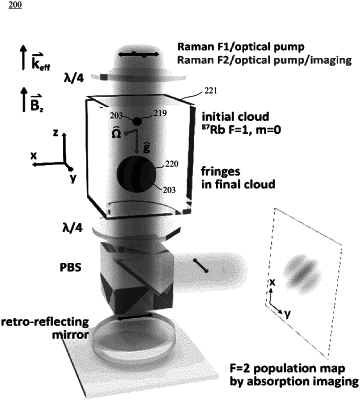| CPC G01C 19/62 (2013.01) [G01B 9/0203 (2013.01); G01P 15/093 (2013.01); G21K 1/067 (2013.01); G21K 1/12 (2013.01); G01C 19/64 (2013.01)] | 27 Claims |

|
1. A process for extracting inertial parameters, the process comprising:
subjecting gyroscope atoms in an expanding cold atom cloud formed from a point-source of the gyroscope atoms to modulated light and imprinting a laser phase of the modulated light onto the gyroscope atoms;
producing matter-wave interference among gyroscope atoms in the expanding cold atom cloud formed from the point-source of the gyroscope atoms in response to subjecting the gyroscope atoms in the expanding cold atom cloud to the modulated light;
subjecting the gyroscope atoms in the expanding cold atom cloud to imaging light;
acquiring a plurality of fringe images of the expanding cold atom cloud in response to subjecting the gyroscope atoms in the expanding cold atom cloud to the modulated light and to the imaging light, such that for the plurality of fringe images a subsequent fringe image differs from an immediate prior fringe image by a difference in fringe phase;
producing the difference in fringe phase by changing the laser phase of the modulated light between acquiring individual fringe images;
converting the fringe images into an interferometric phase map;
fitting a linear function of a first phase gradient, a second phase gradient, and the laser phase to interferometric phase map to obtain the first rotation phase gradient, the second rotation phase gradient, and the acceleration phase; and
converting the first rotation phase gradient, the second rotation phase gradient, and the acceleration phase from the fitting of the linear function to the interferometric phase map into a rotation rate, rotation direction, and an acceleration of an inertial point-source matter-wave atom interferometer gyroscope in which the gyroscope atoms are disposed to extract inertial parameters comprising the rotation rate, rotational direction, and the acceleration.
|